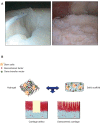Current perspectives in stem cell research for knee cartilage repair
- PMID: 24520197
- PMCID: PMC3897321
- DOI: 10.2147/SCCAA.S42880
Current perspectives in stem cell research for knee cartilage repair
Abstract
Protocols based on the delivery of stem cells are currently applied in patients, showing encouraging results for the treatment of articular cartilage lesions (focal defects, osteoarthritis). Yet, restoration of a fully functional cartilage surface (native structural organization and mechanical functions) especially in the knee joint has not been reported to date, showing the need for improved designs of clinical trials. Various sources of progenitor cells are now available, originating from adult tissues but also from embryonic or reprogrammed tissues, most of which have already been evaluated for their chondrogenic potential in culture and for their reparative properties in vivo upon implantation in relevant animal models of cartilage lesions. Nevertheless, particular attention will be needed regarding their safe clinical use and their potential to form a cartilaginous repair tissue of proper quality and functionality in the patient. Possible improvements may reside in the use of biological supplements in accordance with regulations, while some challenges remain in establishing standardized, effective procedures in the clinics.
Keywords: cartilage repair; clinical trials; focal defects; knee; osteoarthritis; stem cells.
Figures
References
-
- O’Driscoll SW. The healing and regeneration of articular cartilage. J Bone Joint Surg Am. 1998;80(12):1795–1812. - PubMed
-
- Cucchiarini M, Madry H. Gene therapy for cartilage defects. J Gene Med. 2005;7(12):1495–1509. - PubMed
-
- Hunziker EB, Michel M, Studer D. Ultrastructure of adult human articular cartilage matrix after cryotechnical processing. Microsc Res Tech. 1997;37(4):271–284. - PubMed
-
- Burr DB. Anatomy and physiology of the mineralized tissues: role in the pathogenesis of osteoarthrosis. Osteoarthritis Cartilage. 2004;12(Suppl A):S20–S30. - PubMed
-
- Orth P, Cucchiarini M, Kohn D, Madry H. Alterations of the subchondral bone in osteochondral repair – translational data and clinical evidence. Eur Cell Mater. 2013;25:299–316. - PubMed
Publication types
LinkOut - more resources
Full Text Sources
Other Literature Sources


